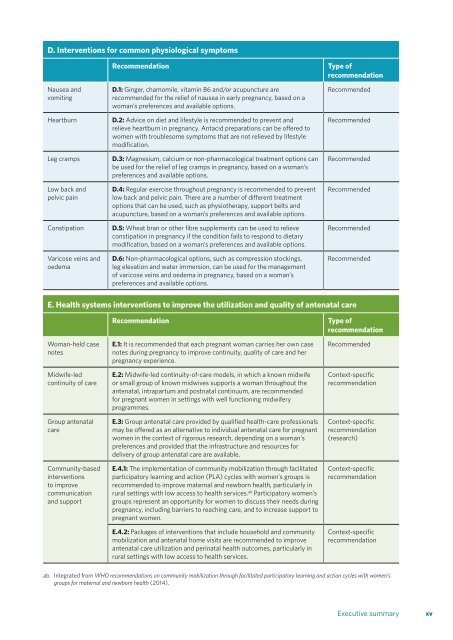WHO recommendations on antenatal care for a positive pregnancy experience
5pAUd5Zhw
5pAUd5Zhw
You also want an ePaper? Increase the reach of your titles
YUMPU automatically turns print PDFs into web optimized ePapers that Google loves.
D. Interventi<strong>on</strong>s <strong>for</strong> comm<strong>on</strong> physiological symptoms<br />
Nausea and<br />
vomiting<br />
Heartburn<br />
Leg cramps<br />
Low back and<br />
pelvic pain<br />
C<strong>on</strong>stipati<strong>on</strong><br />
Varicose veins and<br />
oedema<br />
Recommendati<strong>on</strong><br />
D.1: Ginger, chamomile, vitamin B6 and/or acupuncture are<br />
recommended <strong>for</strong> the relief of nausea in early <strong>pregnancy</strong>, based <strong>on</strong> a<br />
woman’s preferences and available opti<strong>on</strong>s.<br />
D.2: Advice <strong>on</strong> diet and lifestyle is recommended to prevent and<br />
relieve heartburn in <strong>pregnancy</strong>. Antacid preparati<strong>on</strong>s can be offered to<br />
women with troublesome symptoms that are not relieved by lifestyle<br />
modificati<strong>on</strong>.<br />
D.3: Magnesium, calcium or n<strong>on</strong>-pharmacological treatment opti<strong>on</strong>s can<br />
be used <strong>for</strong> the relief of leg cramps in <strong>pregnancy</strong>, based <strong>on</strong> a woman’s<br />
preferences and available opti<strong>on</strong>s.<br />
D.4: Regular exercise throughout <strong>pregnancy</strong> is recommended to prevent<br />
low back and pelvic pain. There are a number of different treatment<br />
opti<strong>on</strong>s that can be used, such as physiotherapy, support belts and<br />
acupuncture, based <strong>on</strong> a woman’s preferences and available opti<strong>on</strong>s.<br />
D.5: Wheat bran or other fibre supplements can be used to relieve<br />
c<strong>on</strong>stipati<strong>on</strong> in <strong>pregnancy</strong> if the c<strong>on</strong>diti<strong>on</strong> fails to resp<strong>on</strong>d to dietary<br />
modificati<strong>on</strong>, based <strong>on</strong> a woman’s preferences and available opti<strong>on</strong>s.<br />
D.6: N<strong>on</strong>-pharmacological opti<strong>on</strong>s, such as compressi<strong>on</strong> stockings,<br />
leg elevati<strong>on</strong> and water immersi<strong>on</strong>, can be used <strong>for</strong> the management<br />
of varicose veins and oedema in <strong>pregnancy</strong>, based <strong>on</strong> a woman’s<br />
preferences and available opti<strong>on</strong>s.<br />
Type of<br />
recommendati<strong>on</strong><br />
Recommended<br />
Recommended<br />
Recommended<br />
Recommended<br />
Recommended<br />
Recommended<br />
E. Health systems interventi<strong>on</strong>s to improve the utilizati<strong>on</strong> and quality of <strong>antenatal</strong> <strong>care</strong><br />
Woman-held case<br />
notes<br />
Midwife-led<br />
c<strong>on</strong>tinuity of <strong>care</strong><br />
Group <strong>antenatal</strong><br />
<strong>care</strong><br />
Community-based<br />
interventi<strong>on</strong>s<br />
to improve<br />
communicati<strong>on</strong><br />
and support<br />
Recommendati<strong>on</strong><br />
E.1: It is recommended that each pregnant woman carries her own case<br />
notes during <strong>pregnancy</strong> to improve c<strong>on</strong>tinuity, quality of <strong>care</strong> and her<br />
<strong>pregnancy</strong> <strong>experience</strong>.<br />
E.2: Midwife-led c<strong>on</strong>tinuity-of-<strong>care</strong> models, in which a known midwife<br />
or small group of known midwives supports a woman throughout the<br />
<strong>antenatal</strong>, intrapartum and postnatal c<strong>on</strong>tinuum, are recommended<br />
<strong>for</strong> pregnant women in settings with well functi<strong>on</strong>ing midwifery<br />
programmes.<br />
E.3: Group <strong>antenatal</strong> <strong>care</strong> provided by qualified health-<strong>care</strong> professi<strong>on</strong>als<br />
may be offered as an alternative to individual <strong>antenatal</strong> <strong>care</strong> <strong>for</strong> pregnant<br />
women in the c<strong>on</strong>text of rigorous research, depending <strong>on</strong> a woman’s<br />
preferences and provided that the infrastructure and resources <strong>for</strong><br />
delivery of group <strong>antenatal</strong> <strong>care</strong> are available.<br />
E.4.1: The implementati<strong>on</strong> of community mobilizati<strong>on</strong> through facilitated<br />
participatory learning and acti<strong>on</strong> (PLA) cycles with women’s groups is<br />
recommended to improve maternal and newborn health, particularly in<br />
rural settings with low access to health services. ab Participatory women’s<br />
groups represent an opportunity <strong>for</strong> women to discuss their needs during<br />
<strong>pregnancy</strong>, including barriers to reaching <strong>care</strong>, and to increase support to<br />
pregnant women.<br />
E.4.2: Packages of interventi<strong>on</strong>s that include household and community<br />
mobilizati<strong>on</strong> and <strong>antenatal</strong> home visits are recommended to improve<br />
<strong>antenatal</strong> <strong>care</strong> utilizati<strong>on</strong> and perinatal health outcomes, particularly in<br />
rural settings with low access to health services.<br />
Type of<br />
recommendati<strong>on</strong><br />
Recommended<br />
C<strong>on</strong>text-specific<br />
recommendati<strong>on</strong><br />
C<strong>on</strong>text-specific<br />
recommendati<strong>on</strong><br />
(research)<br />
C<strong>on</strong>text-specific<br />
recommendati<strong>on</strong><br />
C<strong>on</strong>text-specific<br />
recommendati<strong>on</strong><br />
ab. Integrated from <str<strong>on</strong>g>WHO</str<strong>on</strong>g> <str<strong>on</strong>g>recommendati<strong>on</strong>s</str<strong>on</strong>g> <strong>on</strong> community mobilizati<strong>on</strong> through facilitated participatory learning and acti<strong>on</strong> cycles with women’s<br />
groups <strong>for</strong> maternal and newborn health (2014).<br />
Executive summary<br />
xv


